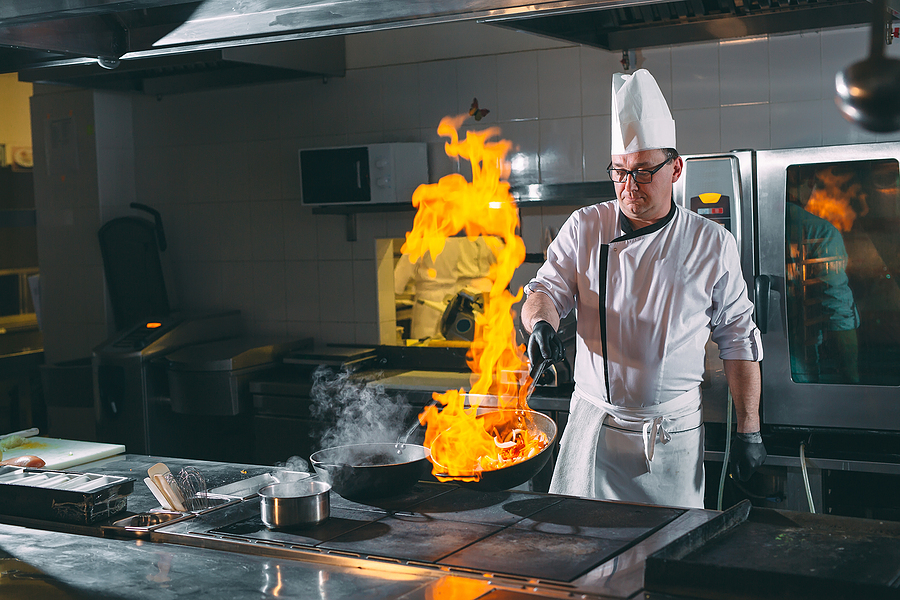Do you think of fire extinguishers as boring pieces of safety equipment? You shouldn’t. These unassuming red canisters are lifesavers in disguise.
When seconds count, a fire extinguisher can be the difference between life and death. It can stop a small fire from turning into an inferno. It can clear a path to safety when exits are blocked. Fire extinguishers give people the power to take action when disaster strikes.
Let’s explore why every commercial kitchen needs them and how to use them properly.
Fire Triangle
To tap the full lifesaving potential of fire extinguishers, you need to understand fire itself. Specifically, the fire triangle.
The fire triangle’s 3 sides represent the 3 elements required for fire:
- Heat
- Fuel
- Oxygen
Remove any one side and fire dies. It’s that simple.
Fire extinguishers work by attacking one or more sides of the triangle. They either cool heat, smother oxygen, or remove fuel sources.
Understanding this theory helps you use extinguishers more effectively. You can strategically target the element that will most quickly suppress the specific fire at hand.
Heat
Heat ignites combustible materials. More heat makes fires burn stronger and spread faster.
Fire extinguishers canreduce heat by releasing non-flammable gases that absorb thermal energy. This cooling effect helps suppress the blaze.
Substances like water also reduce heat through an endothermic reaction. The water soaks into burning material and evaporates, carrying away heat energy.
Fuel
The material that’s burning – wood, oil, paper, etc – provides fuel for the fire. Remove the fuel, and the fire starves.
Fire extinguishers break down large fuel sources into smaller bits, separating the burning material. This removes the fire’s food source.
Foams and gels work by coating fuels with non-flammable chemicals. This seals fuels from oxygen and isolates the fire.
Oxygen
Oxygen sustains burning. Increase airflow, and fire grows. Limit oxygen, and fire dies.
Some fire extinguishers work by displacing or diluting oxygen with inert gases. Less oxygen means less vigorous burning.
Other agents like foams and gels smother fires by creating a barrier between the oxygen and the fuel.
Understand the fire triangle, and you can outsmart fire into submission. Equipped with an extinguisher, you have a fighting chance.
Class A Fires
Class A fires involve common combustibles like wood, paper, plastics, and fabric. Think furniture, drapes, decor, tablecloths, etc.
Water extinguishers are ideal for Class A fires. The water cools the burning material and prevents rekindling.
Foam extinguishers also work on Class A fires. The foam blankets the fuel, separating it from oxygen.
For Class A fires, aim low at the base of flames and sweep side to side. Soak burning material thoroughly. Watch for re-ignition.
Class B Fires
Flammable liquids like grease, oil, gasoline, solvents, and paints fuel Class B fires.
Foam extinguishers smother Class B fires, preventing reignition. The thick blanket separates fuel from air.
Powder agents work by interrupting the fire’s chemical reaction. The powder disperses and clings to surfaces.
CO2 extinguishers blast fires with carbon dioxide to displace oxygen. The cold gas also helps cool fuels.
Aim foam and powder types low at the base of Class B fires. Discharge CO2 types from a safe distance.
Class K Fires
Commercial kitchens deal with a special Class K: cooking oils and grease.
Wet chemical extinguishers combat Class K fires. They produce a soapy foam that clings to surfaces and prevents reflash.
The chemical reaction saponifies the oils to create a Heat-Actuated Deployable Extinguishing (H.A.D.E) barrier. This suppresses the fire.
Class K extinguishers are essential for commercial kitchens. Grease and cooking oil fires re-ignite easily. Class K agents prevent that.
Aim low at the base of the fire. Discharge very close to the fuel source for maximum effect.
Fire Extinguisher Training
Simply having fire extinguishers is not enough. You must know when and how to use them properly.
Annual hands-on fire extinguisher training is essential:
- Cover fire triangle theory and extinguisher types
- Demonstrate the PASS technique (Pull, Aim, Squeeze, Sweep)
- Let trainees practice suppressing live fires
- Refresh knowledge of manufacturer instructions
- Review when to fight fires vs when to evacuate
Certified instructors simulate real-world conditions for the best experience.
Fire Extinguisher Tips & Tricks
Optimize your restaurant fire extinguishers:
- Install near exits for easy access
- Use signs to pinpoint locations
- Mount at the manufacturer’s recommended height
- Use locks to prevent tampering
- Inspect monthly to ensure full charge
- Schedule annual maintenance with certified techs
- Ensure cooking staff know which extinguishers to use for appliance fires
Proper selection, placement, maintenance and training ensure your fire extinguishers work when it matters most. Don’t let them collect dust – keep them primed to save lives.
Fire Safety Layers
Fire extinguishers are crucial, but are only one part of overall fire safety.
Use a layered approach:
- Maintain kitchen suppression systems
- Conduct regular fire drills
- Keep exits clearly marked and unobstructed
- Stock adequate first aid and emergency supplies
- Have evacuation protocols and rally points
With planning and practice, your team will be ready to respond quickly if disaster ever strikes.
Final Thoughts
Restaurant fire extinguishers are silent heroes waiting for the moment to act. They save lives and property through proper use.
Give your team the life-saving tools and knowledge needed to suppress flames and clear paths to safety.
